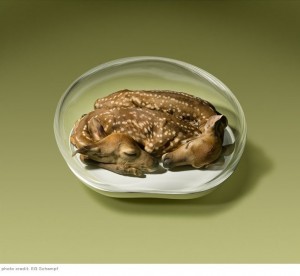Slipping the fur skin of a dead animal over a perfectly crafted taxidermy form produces a visual illusion of life, much in the tradition of a trompe l’oeil painting. In traditional taxidermy terms, the relationship between man and animal is that of a hunter conquering nature. The tradition of taxidermy as art dates back to English Victorian-era taxidermist Walter Potter, who created anthropomorphic dioramas of squirrels playing cards in a parlor, a classroom of rabbits seated in rows of long wooden desks, and many other assorted scenarios that more closely resemble illustrations from a Beatrix Potter children’s book than Damien Hirst or Maurizio Cattelan’s respective, well-known animal form artworks. In the works of taxidermy art by AC Wilson and Peregrine Honig discussed here, however, the taxidermy of a young animal (or, in human terms, of ‘children’) locates the work in a tradition much more akin to Walter Potter’s delicate dioramas. Wilson and Honig’s works stand in contrast to the more brash, cynical nature of Hirst and Cattelan’s works by allowing the darker underbelly of childhood fairytale and fantasy to speak through their forms.
Walter Potter was initially inspired to create his taxidermy dioramas by his sister, Jane, who showed him a book of nursery rhymes. He displayed his taxidermy works in his very own Walter Potter’s Museum of Curiosities, located in Sussex, England, which first opened in 1861; by the time of his death in 1914, the museum housed about 10,000 taxidermy objects. Potter’s dioramas embodied a sort of morbidity of childhood, which coincided with the Victorian era’s idealization of childhood, as evidenced by Charles Dickens’ portrayals of children as ‘innocents’—the symbols of all that was “good in the world,” before the onset of adulthood institutions and behaviors.[1] Quite literally speaking, the perceived morbidity of childhood is subject of a vast visual tradition, established and popular throughout England in the late 1800s, known as post-mortem photography. Contemporary artists Peregrine Honig and AC Wilson harken back to these visual representations of dead children in artworks that suggest the absurd, circular proximity of life and death.
Read the full essay on the OPP Blog: http://blog.otherpeoplespixels.com/opp-art-critics-series-the-child-is-dead-taxidermy-art-as-resurrected-victorian-post-mortem-photography




